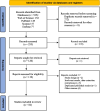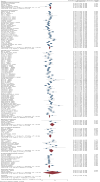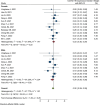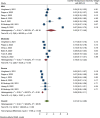An umbrella review of the prevalence of depression during the COVID-19 pandemic: Call to action for post-COVID-19 at the global level
- PMID: 39716132
- PMCID: PMC11664853
- DOI: 10.1186/s12889-024-21085-5
An umbrella review of the prevalence of depression during the COVID-19 pandemic: Call to action for post-COVID-19 at the global level
Abstract
Background: Pandemics can lead to mental health problems such as depression. This meta-analysis of meta-analyses aimed to estimate the precise prevalence of depression during the COVID-19 pandemic.
Methods: Web of Science, PubMed, Scopus, and Embase were searched for published meta-analyses using relevant keywords, such as depression, prevalence, COVID-19, and meta-analysis up to March 18, 2024 according to the PRISMA guidelines. Relevant journals as well as the search engine Google Scholar were manually searched to discover more articles. The AMSTAR tool was used for quality assessment. A random-effects model was used for the analysis. All analyses were conducted using the STATA 17 software.
Results: Of 535 records, 82 meta-analyses were included. The results showed that the overall prevalence of depression was 30% [95% CI: 29-32] with a high heterogeneity (I2: 90.98%). The highest prevalence of depression according to population group was found in medical students (40% [30-49]), specific groups (40% [3-78]), and patients (36% [27-45]). The results of meta-regression based on the different times between the start of COVID-19 and the last date of search in the articles (week) and the prevalence of depression, showed that each past week of Covid-19 increases the prevalence of depression by almost 0.00021% [95% CI: -0.00025, 0.00068], P-value: 0.36, but "time" is not a significant predictor of an increase in depression.
Conclusions: The results showed that the prevalence of depression was high during the COVID-19 pandemic, particularly among medical students. Policy makers should pay more attention to these groups and those who are at greater risk. Primary mental health interventions and policies are necessary to support the mental health of these individuals during the pandemic.
Keywords: COVID-19; Depression; Meta-analysis; Pandemic; Prevalence.
© 2024. The Author(s).
Conflict of interest statement
Declarations. Ethics approval and consent to participate: Not applicable. Consent for publication: Not applicable. Competing interests: The authors declare no competing interests.
Figures







Similar articles
-
Estimation of the prevalence of anxiety during the COVID-19 pandemic: A meta-analysis of meta-analyses.BMC Public Health. 2024 Oct 15;24(1):2831. doi: 10.1186/s12889-024-19729-7. BMC Public Health. 2024. PMID: 39407138 Free PMC article.
-
The prevalence of anxiety and depression among healthcare workers during the COVID-19 pandemic: An umbrella review of meta-analyses.Prog Neuropsychopharmacol Biol Psychiatry. 2021 Apr 20;107:110247. doi: 10.1016/j.pnpbp.2021.110247. Epub 2021 Jan 19. Prog Neuropsychopharmacol Biol Psychiatry. 2021. PMID: 33476692 Free PMC article.
-
Impact of the COVID-19 pandemic on the mental health of hospital staff: An umbrella review of 44 meta-analyses.Int J Nurs Stud. 2022 Jul;131:104272. doi: 10.1016/j.ijnurstu.2022.104272. Epub 2022 Apr 27. Int J Nurs Stud. 2022. PMID: 35576637 Free PMC article.
-
Global prevalence of anxiety and depression among medical students during the COVID-19 pandemic: a systematic review and meta-analysis.BMC Psychol. 2024 Jun 10;12(1):338. doi: 10.1186/s40359-024-01838-y. BMC Psychol. 2024. PMID: 38858700 Free PMC article.
-
Stress, anxiety, depression and sleep disturbance among healthcare professional during the COVID-19 pandemic: An umbrella review of 72 meta-analyses.PLoS One. 2024 May 9;19(5):e0302597. doi: 10.1371/journal.pone.0302597. eCollection 2024. PLoS One. 2024. PMID: 38722888 Free PMC article.
Cited by
-
Emotional distress during the first year of the COVID-19 pandemic-large sample serbian study.Sci Rep. 2025 Apr 11;15(1):12459. doi: 10.1038/s41598-025-96452-2. Sci Rep. 2025. PMID: 40216895 Free PMC article.
References
Publication types
MeSH terms
Grants and funding
LinkOut - more resources
Full Text Sources
Medical
Miscellaneous

